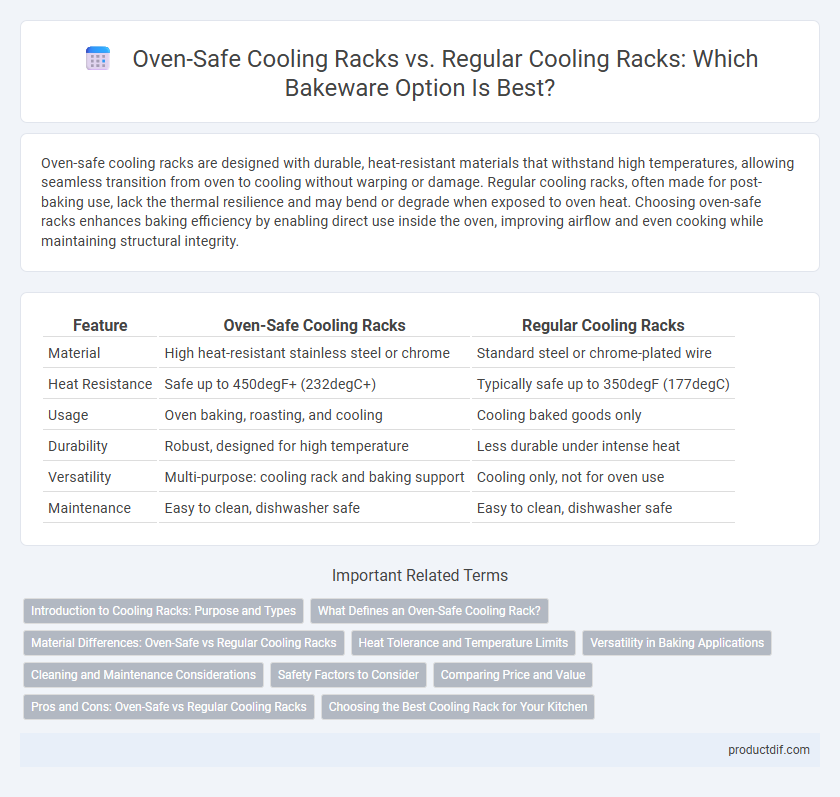Oven-safe cooling racks are designed with durable, heat-resistant materials that withstand high temperatures, allowing seamless transition from oven to cooling without warping or damage. Regular cooling racks, often made for post-baking use, lack the thermal resilience and may bend or degrade when exposed to oven heat. Choosing oven-safe racks enhances baking efficiency by enabling direct use inside the oven, improving airflow and even cooking while maintaining structural integrity.
Table of Comparison
| Feature | Oven-Safe Cooling Racks | Regular Cooling Racks |
|---|---|---|
| Material | High heat-resistant stainless steel or chrome | Standard steel or chrome-plated wire |
| Heat Resistance | Safe up to 450degF+ (232degC+) | Typically safe up to 350degF (177degC) |
| Usage | Oven baking, roasting, and cooling | Cooling baked goods only |
| Durability | Robust, designed for high temperature | Less durable under intense heat |
| Versatility | Multi-purpose: cooling rack and baking support | Cooling only, not for oven use |
| Maintenance | Easy to clean, dishwasher safe | Easy to clean, dishwasher safe |
Introduction to Cooling Racks: Purpose and Types
Oven-safe cooling racks are designed to withstand high temperatures, allowing them to be used both for cooling baked goods and as a roasting or baking rack inside the oven. Regular cooling racks, typically made from lightweight materials, are intended solely for cooling purposes and cannot safely be placed in an oven. Understanding these types helps bakers select the right rack for tasks such as air circulation during cooling or oven roasting for optimal baking results.
What Defines an Oven-Safe Cooling Rack?
An oven-safe cooling rack is specifically designed to withstand high temperatures typically up to 500degF or more, made from durable materials such as stainless steel or coated metal that resist warping and rusting. Unlike regular cooling racks, oven-safe racks feature a sturdy construction with tightly woven grids or reinforced legs to support heavier baked goods during baking or roasting. These racks are labeled explicitly for oven use, ensuring they can be safely placed inside ovens without compromising structural integrity or food safety.
Material Differences: Oven-Safe vs Regular Cooling Racks
Oven-safe cooling racks are typically made from heavy-duty stainless steel with a non-stick or heat-resistant coating, enabling them to withstand high oven temperatures without warping or releasing harmful substances. Regular cooling racks often utilize lighter materials such as chrome-plated steel or aluminum, which may not tolerate oven heat and can degrade or discolor under high temperatures. The material composition directly affects durability, heat resistance, and safety during baking applications requiring exposure to direct oven heat.
Heat Tolerance and Temperature Limits
Oven-safe cooling racks are designed with materials like stainless steel that withstand temperatures up to 500degF or higher, ensuring durability during baking and roasting. Regular cooling racks, often coated with non-stick or plastic finishes, have lower heat tolerance, typically safe only up to 400degF, making them unsuitable for direct oven use. Choosing oven-safe racks enhances versatility, allowing seamless transition from cooling baked goods to use as roasting racks without heat damage.
Versatility in Baking Applications
Oven-safe cooling racks offer superior versatility in baking applications by allowing direct use inside the oven for roasting, broiling, and draining excess fat without transferring food between surfaces. Regular cooling racks are primarily designed for cooling baked goods and may warp or become damaged under high oven temperatures. The heat-resistant construction of oven-safe racks ensures durability and multifunctional use, enhancing efficiency in the kitchen for tasks beyond simple cooling.
Cleaning and Maintenance Considerations
Oven-safe cooling racks are constructed from durable, heat-resistant materials like stainless steel that withstand high temperatures and resist rust, simplifying cleaning and maintenance. In contrast, regular cooling racks, often coated with non-stick surfaces, may degrade over time with frequent washing and exposure to heat, requiring more delicate care. Choosing oven-safe racks reduces the risk of warping and corrosion, ensuring long-lasting usability and easier cleanup after baking.
Safety Factors to Consider
Oven-safe cooling racks are engineered from heat-resistant materials like stainless steel, ensuring they can withstand high temperatures without warping or releasing harmful chemicals, unlike many regular cooling racks made with non-oven-safe coatings or metals. Safety factors to consider include the rack's maximum temperature rating, structural integrity under heat exposure, and non-toxic finishes that prevent food contamination during baking. Using an oven-safe cooling rack minimizes risks of fire hazards, metal leaching, and structural failure, making them essential for baking tasks requiring direct oven use.
Comparing Price and Value
Oven-safe cooling racks typically cost 20-40% more than regular cooling racks due to their enhanced heat resistance and durability. Their value increases for frequent bakers who can use them for both cooling and oven-baking tasks, effectively reducing the need for multiple tools. Regular cooling racks, while more affordable, lack the versatility and longevity of oven-safe models, making them less cost-effective over time.
Pros and Cons: Oven-Safe vs Regular Cooling Racks
Oven-safe cooling racks provide dual functionality, allowing baked goods to cool while also serving as a platform for roasting or baking, thanks to their heat-resistant materials designed to withstand oven temperatures. Regular cooling racks excel in air circulation for cooling but cannot be used in the oven, limiting their versatility. Oven-safe racks often feature sturdier construction and non-toxic coatings, whereas regular racks may be lighter and cheaper but less durable under high heat.
Choosing the Best Cooling Rack for Your Kitchen
Oven-safe cooling racks are designed with durable, heat-resistant materials like stainless steel, allowing you to use them directly in the oven for roasting or baking tasks, whereas regular cooling racks are typically intended only for cooling baked goods and may warp under high temperatures. Choosing the best cooling rack depends on your kitchen needs: prioritize oven-safe options if you require multi-functionality for baking and roasting, while regular racks are suitable for simple cooling purposes. Consider factors such as material durability, heat resistance, size, and grid design to ensure optimal airflow and stability in your baking process.
Oven-Safe Cooling Racks vs Regular Cooling Racks Infographic

 productdif.com
productdif.com